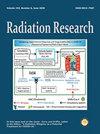超高剂量率对生物分子辐射损伤的影响
摘要
剂量率是辐射诱导生物分子损伤的重要参数之一。已知剂量率的影响会改变生物系统中的辐射毒性。亚致死 DNA 损伤(如碱基损伤和单链断裂)修复的速度和程度以及细胞增殖的速度和程度都受到剂量率的影响。然而,最近临床前应用的超高剂量率(约 40 Gy/s 或更高)辐射模式已被证明可降低生物系统的辐射损伤类型和程度。在这些超高剂量率下,辐射诱导的物理化学和化学过程预计与常规剂量率(CONV)辐照后观察到的不同。目前还不清楚超高辐射剂量条件是否会影响生物分子损伤(如 DNA 损伤)的质(类型)和量(程度)。在此,我们比较研究了在低羟基自由基(-OH)清除率和高羟基自由基清除率条件下,CONV 和 UHDR 对质粒 DNA 模型的通气稀释水溶液和缺氧稀释水溶液中 DNA 链断裂和集群损伤(包括密集累积的病变)形成的间接影响。纯化的超螺旋质粒DNA(pUC19)水溶液是在空气或氮气饱和的条件下制备的,其中添加了Tris缓冲液作为辐射产生的-OH清除剂,清除能力分为低清除能力和高清除能力两种。在不同的清除和环境条件下,使用千伏 X 射线系统以 CONV(0.1 Gy/s)、高剂量率(HDR,25 Gy/s)和超高剂量率(UHDR,55 和 125 Gy/s)对这些 DNA 样品进行辐照。通过凝胶电泳对包括链断裂在内的DNA损伤和包括密集积累的损伤在内的成簇损伤进行定量,并根据剂量-反应曲线计算出这些损伤的产量。在凝胶电泳前使用细菌内切酶(Fpg 和 Nth)处理 DNA,以评估包括密集累积病变在内的非DSB 聚集损伤。与相同剂量条件下 0.1 和 25 Gy/s 照射诱导的这些病变的丰度相比,在氧气存在的情况下,剂量大于 40 Gy 的 55 和 125 Gy/s 超高辐射诱导的孤立断链和 DNA 损伤(包括密集累积的病变)的数量都较低。总体而言,超高强度辐照后,包括密集累积病变在内的链断裂和成簇损伤的产量下降了1.3-3.5倍。无论是通过-OH清除还是从溶液中除去氧气,我们都没有观察到这些差异。此外,我们的研究结果还表明,轨道间重组反应并没有对观察到的剂量率对 DNA 损伤的影响做出贡献。正如预期的那样,剂量率对DNA损伤的影响高度依赖于总剂量,同时也依赖于DNA水溶液中使用的-OH清除能力。这些重要的变量可能也与生物系统有关。在实际应用中,我们的体外质粒 DNA 模型可以精确地改变清除能力和充气条件(空气饱和与 N2 饱和),有助于区分剂量率对生物分子损伤的影响。我们的研究结果表明,自由基-自由基反应对于理解剂量率对 DNA 损伤的影响非常重要。Dose rate is one of the important parameters in radiation-induced biomolecular damage. The effects of dose rate have been known to modify radiation toxicity in biological systems. The rate and extent of sublethal DNA damage (e.g., base damage and single-strand breaks) repair and those of cell proliferation have been manifested by dose rate. However, the recent preclinical application of ultrahigh dose rate [(UHDR) ca. 40 Gy/s and higher] radiation modalities have been shown to lower the type and extent of radiation damage to biological systems. At these UHDR, radiation-induced physicochemical and chemical processes are expected to differ from those observed after irradiation at conventional dose rates (CONV). It is unclear whether these UHDR conditions can affect the quality (type) and quantity (extent) of biomolecular damage such as DNA lesions. Here, we comparatively study the influence of indirect effects of CONV and UHDR on the formation of DNA strand breaks and clustered damage including densely accumulated lesions in an aerated and an anoxic dilute aqueous solution of a plasmid DNA model under low and high hydroxyl radical (•OH) scavenging conditions. Aqueous solutions of purified supercoiled plasmid DNA (pUC19) were prepared in either air- or nitrogen-saturated conditions, with Tris buffer added as the radiation-produced •OH scavenger at low and high scavenging capacities. These DNA samples were irradiated using kV X-ray systems at CONV (0.1 Gy/s) and high dose rate (HDR, 25 Gy/s) as well as UHDR (55 and 125 Gy/s) under different scavenging and environmental conditions. DNA lesions including strand breaks and clustered damage including densely accumulated lesions were quantified by gel electrophoresis and the yields of these lesions were calculated from the dose-response curve. Non-DSB clustered damage including densely accumulated lesions were evaluated by treating DNAs using bacterial endonuclease enzymes (Fpg and Nth) prior to gel electrophoresis. UHDR of 55 and 125 Gy/s induced lower amounts of both isolated strand breaks and clustered DNA damage including densely accumulated lesions at doses >40 Gy in the presence of oxygen, compared to the abundance of these lesions induced by 0.1 and 25 Gy/s irradiation under the same dose conditions. Overall, the strand break and clustered damage including densely accumulated lesions yields decreased by factors of 1.3-3.5 after UHDR. We did not observe these differences either via •OH scavenging or by removing oxygen from the solution. In addition, our results point out that the inter-track recombination reactions did not contribute to the observed dose-rate effects on DNA damage. The effects of dose rate on DNA damage are highly dependent on the total dose, as expected, but also on the •OH scavenging capacity that is employed in the aqueous DNA solutions. These important variables may be relevant in biological systems as well. On a practical level, our in vitro plasmid DNA model, which permits to precisely vary the •OH scavenging capacity and gassing conditions (air saturated vs. N2 saturated) can help to differentiate dose-rate effects on biomolecular damage. Our results indicate that the radical-radical reactions are important in understanding the dose-rate effect on DNA damage.

 求助内容:
求助内容: 应助结果提醒方式:
应助结果提醒方式:


